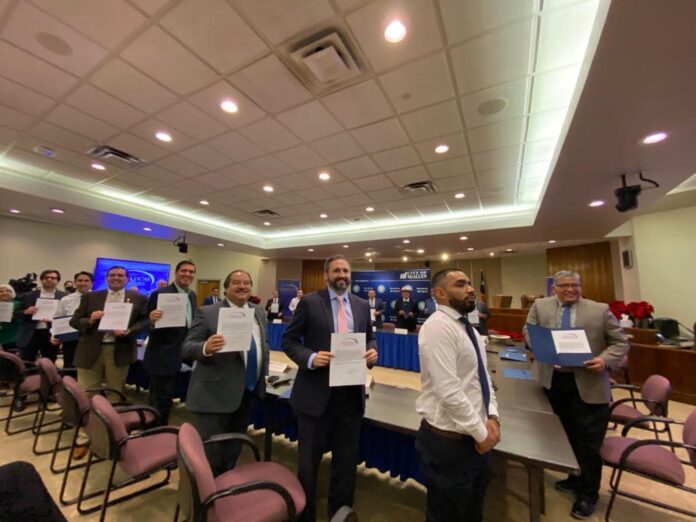In an important step in increasing commercial traffic across the border, state and local officials celebrated an agreement with the federal government that puts the Anzalduas International Bridge one step closer to making it a full-service cargo port of entry.
Officials with the city of McAllen signed a full cargo donations acceptance agreement in which the federal government agreed to operate the cargo facilities that will be constructed at the bridge.
“In order to have the federal government man facilities like the ones you find at a port of entry, you have to go through what’s called the DAP program, the Donations Acceptance Program,” McAllen City Manager Roel “Roy” Rodriguez said Wednesday.
The DAP, established in 2015, enables the federal government to accept property or services from private sector and government entities. Those donations will then be used by U.S. Customs and Border Protection to support their operations.
“You basically design all of the infrastructure that you’re going to build — roadways, any appurtenances, drainage, and then the facilities themselves that are going to house federal officers, cargo bays, everything,” Rodriguez said. “After this is constructed, (it) will be donated to the federal government.”
The agreement is part of a larger effort by the city and other local partners to finally allow the transport of cargo through the bridge.
The Anzalduas bridge, owned and operated by the city of McAllen in partnership with the cities of Hidalgo and Mission, opened in 2010 for vehicular traffic.
In 2016, the bridge opened for southbound empty truck traffic, but it will finally expand to allow for north and southbound cargo trucks with the construction of these new facilities.
Of the five international bridges in Hidalgo County, only the Pharr International Bridge currently allows cargo traffic.
The approximately $50 million project will be funded with $22 million from the state through the Texas Department of Transportation.
The city of McAllen will fund the rest, providing $4 million that remained from other improvement projects and another $24 million that the city will borrow and then pay off with revenue from the bridge.
Construction of the new cargo port will include multiple lanes for trucks and new cargo bays for truck inspections.
The city expects to bid out the project in March or April 2022 and expects to begin construction in the summer, according to Rodriguez.
During the signing ceremony, state Sen. Juan “Chuy” Hinojosa, D-McAllen, lauded the project and the agreement as a boon to the economy of South Texas, the state and Mexico.
“Over 20 years ago, the trade with Mexico was around $54 billion. About 20 years later, now, it’s close to $300 billion,” Hinojosa said. “That growth will continue. If you look at the Pharr bridge, it does over $35 billion a year in trade with Mexico and now with Anzalduas coming on board, the trade will only increase.”
But the value of trade along the border and its significance to the state and the nation is something that is underappreciated, according to state Rep. Terry Canales, D-Edinburg.
Canales said the amount of time and effort it took to bring the project to fruition underscored that problem.
“It underscores that we have to fight tooth and nail for every dollar we bring down here,” Canales said. “We have to fight twice as hard as the rest of the state of Texas when this is an economic engine.”
He stressed that the economy of the Rio Grande Valley greatly impacts, not just the Texas economy, but also the economy of the rest of the United States.
“When the rest of the world was in a recession, the Rio Grande Valley was not and that’s because of the ports of entry,” Canales said. “They are billion-dollar economic engines. We have failed to invest what we need to invest to secure not only our border through infrastructure but to secure our economic success.”
Both discouraged and encouraged by the process, Canales said he hoped state and federal leadership would take note of the progress they expect to make with the expansion of trade.
“Because this is a drop in the bucket, this is a budget dust in what they should be investing in the Rio Grande Valley,” Canales said. “And when (and) if they paid attention to the profit, and the exponential growth that will transpire by this minimal investment … they should take note and invest much more.”





